After a few uneasy years for many local bike shops, the people whose businesses are built around Portland’s core of daily bike commuters say they’re feeling the boom.
One week after a new Census estimate that Portland added 5,000 net new bike commuters in 2014 to reach a total of 23,000 citywide, we called a few of the city’s biggest bike sellers to see if that seemed right.
Yep. And what’s more, they said the boom got bigger in 2015.
“I know that we did sell more commuter bikes that year than we did the year before,” said Matt Karre, general manager at River City Bicycles, which operates Portland’s single biggest bike shop in inner Southeast. “For 2015, it kind of blew 2014 out of the water.”
Kelly Aicher, co-owner and general manager at the six-location Bike Gallery, said the same thing.
“When you look at the smaller, focused segments — disc-equipped hybrids, fenders, disc-brake-equipped road bikes — that’s the category that I would say we’ve seen steady growth the last couple of years for sure,” Aicher said. “I would say that this year it’s probably even stronger than the previous year.”
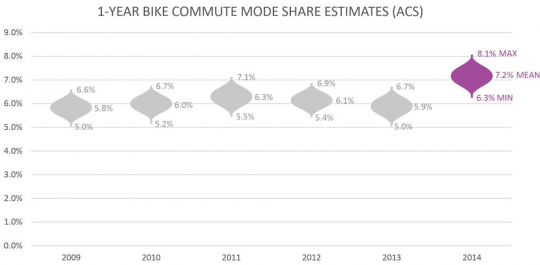
At West End Bikes, where the focus is on racing as well as the commuter and lifestyle market, co-owner Mark Ontiveros said his business is up 20 percent in the last two years.
“It seems like there’s an uptick, and this whole town: people are moving here, and it’s interesting,” Ontiveros said. “I think we’re all doing OK because we built the bike lanes, we created this culture, and I think people are being enticed. … They’re riding bikes. And they probably can’t afford to own cars with these friggin’ rents.”
“Margins are skinnier than ever — nothing is easy,” Ontiveros said. “But service is up.”
East of Interstate 205, the jump in sales hasn’t been as big. But it’s there, at least for the Outer Rim shop at NE 106th and Halsey.
“It’s definitely better than it was a couple years ago,” said Mark Andresen, a mechanic at the shop. “In terms of repairs, definitely. We’ve increased the amount of space … that’s probably three times what we had a couple of years ago.”
“I would say a third of the bikes that we have here, people complain about having to leave it here for a day or two because they say it’s their only mode of transportation,” Andresen said.
Advertisement
The Outer Rim is just six years old and West End Bikes is five years old, so some of their growth is likely related to getting established as businesses. The improving economy is another factor — though all these businesses said it was clearly their transportation segment that seemed to be growing strongly in 2014 and 2015.
“I think it’s just people moving into town. Literally every single day, we get people who say ‘I just moved to Portland and I need a bike.’ It happens every day. Sometimes more than once a day.”
— Matt Karre, general manager at River City Bicycles
“I think it’s just people moving into town,” Karre said. “Literally every single day, we get people who say ‘I just moved to Portland and I need a bike.’ It happens every day. Sometimes more than once a day.”
Portland’s unusually warm and dry weather in 2015 has also been also a big factor this year, Karre added.
Not every bike shop, though, is riding high on sales. Of the six shops we polled for this story, exactly one said that unit sales fell in 2014: the Community Cycling Center, which is based in inner Northeast Portland and exclusively sells used bikes.
“We’re still a growing shop; we’re not really suffering,” CCC Retail Manager David Kurushima said. But that’s not because of more unit sales; that’s because people are buying more expensive bikes.
“We’ve also seen declines in service overall year on year,” Kurushima said. “I think a lot of that has to do with the unique position of our shop and our position in the Alberta neighborhood. I think we’re seeing a lot less sort of older bike repairs that need to get done and more and more affluent customers who have just opted to buy a new bike rather than get an old bike repaired. Because of that, we see a lot more retail sales and not so much demand for service. … I think that’s a reflection of the changing demographic of North Portland in general.”
Kurushima said there has been a small uptick in unit sales in 2015, but he attributed that to weather.
Another factor for the CCC is that they don’t ride the rising tide of the Portland area’s strengthening economy as much as new-bike shops tend to, because demand for used bikes tends to hold up during recessions.
“We definitely see obviously increased demand in up years as do all other shops,” Kurushima said. “[But] we see a steady increase in demand in down economic years as well.”


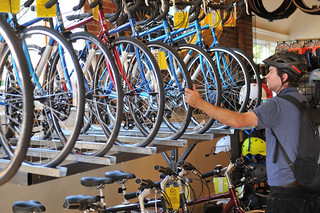
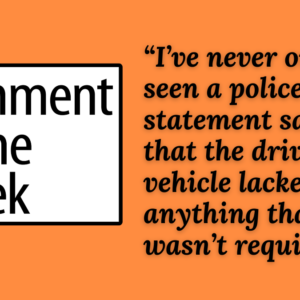
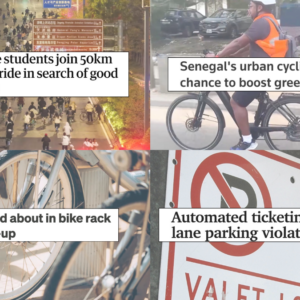

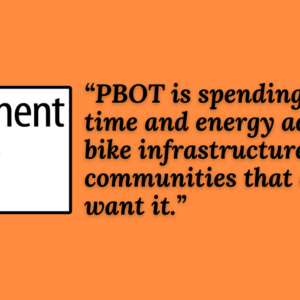
Thanks for reading.
BikePortland has served this community with independent community journalism since 2005. We rely on subscriptions from readers like you to survive. Your financial support is vital in keeping this valuable resource alive and well.
Please subscribe today to strengthen and expand our work.
And CCC’s used bike prices have as a trend gotten pretty high…potentially depressing sales volumes…thought see higher prices reflects more competitive sales environment, more awareness of old good stuff, (and thinner pool of good used bikes).
Hi Todd, thanks for your astute thoughts! It sounds like you’ve been in our shop a lot and we thank you for your support. As full-service shop and a non-profit we are very conscious our need to work hard to balance our organization’s mission with the obligations we have to contribute to a growing and sustainable bicycle economy. We receive a wide variety of bicycle donations at our shop and we have always felt that we owe it our generous donors to get the most value out of their donations so that we can continue, and grow, the work we do. Also, as you noticed, we do try to reflect market value for all of our products and services. As a community resource and a good-neighbor to other bike shops we strive to be a contributor to Portland’s vibrant and prosperous bicycle economy; undervaluing our goods and services only works to undermine those efforts. We understand that there are a number of barriers to cycling, not least of which are financial barriers, so we do try our best to have a wide variety of bicycles for commuters and recreational riders with varying income levels. We also offer discounts to customers who are eligible for benefits from SNAP or Medicaid. Thanks again for your support and your engagement in sustainable transportation in the Portland area!
Does anyone know, roughly, the percentage of car trips in Portland that could be bicycle trips instead? Has anyone tried to calculate this?
Lets say trips under 5 miles that don’t require special equipment (like a cargo bike to carry large loads) by Portlander’s age 8-65.
People under 8 years old can ride on someone else’s bike, and many people still ride age age 70, 80 and higher. Portland is only 20 miles across. So almost every personal trip in Portland can potentially be done by bike. Heavy freight trips are usually considered separately. Sure, a family trip from outer SE Portland to the extreme city limit in the NW is a challenging bike ride… but some people do rides like that just for fun!
But to answer your question, the average trip in the Portland Metro area was 4.4 miles in 2011, a decrease from 5.1 miles in 1994. Average trip length was only 3.2 miles in N, NE and SE Portland west of I-205. So half of current trips would take 20 minutes or less by bike in most of the city.
Source:
http://www.portlandoregon.gov/transportation/article/452524
As more people and businesses move into central parts of the city, the average trip length will continue to go down. I know that moving to central NE Portland and becoming car free made us choose shorter trips on average.
That’s so depressing. Little wonder that we have an obesity epidemic, with all the corollary health consequences, when people are driving these pathetically short distances. At this rate, we’re going to need much bigger parking lots at the hospitals.
More parking lots at hospitals. No! not necessary. Most cardiac incidents are ambulance delivery then to the morgue.
Spot on. I have a friend who lives near PSU and drives to work at the Burnside bridgehead. He then proceeds to complain all morning about how he’s putting on weight and can’t find a good parking space on the inner east side. I shake my head in wonder.
I am in the high range of riders. I ride with all types but usually with riders in the “retirement age” groups topping in the 87 YO range. Younger riders are either mortified at riding with “Old Farts” or cannot keep up with us. Funny thing is today when riding through Beaverton on the way to have coffee in NW PDX. 3 different cars with youth (under 25) kids drove up next to me and complimented me on my “Sweet ride!” They mentioned that they usually could only find dark bikes and darker biker clothing. This is something I have asked at bike shops and none of them are inclined to supply anything but “Ninja” clothing or bikes. For some reason Most of the marketeers are trying to make sure that none of the motorists can see riders when the sun is not high in the sky or it is cloudy and rainy. I guess it is something that is learned with age, not on Twitter.
In response to the low visibility clothing comment: Local wholesaler Castelli has many excellent solutions in reflective and hi vis colors.
Thanks
All of them.
The average trip in SW is probably 2.5 miles with 200ft elevation change. Easy on an electric bike, but biking is “too hard” if all you have available is the bank’s luxury SUV, a lot of cheap gasoline, and abundant free parking.
Eric! My average ride is from Washington square to stops in NW in the vicinity of 24th and Turmond. Next to Grant high area and then to St Johns or Gateway and sometimes to Troutdale. Other times it is Scappose or St. Helens and back. 200 foot elevation is only a bump in the road. True, many are now riding electric bikes but I still ride my 27 speed Italian with Campy components. it is steel also.
That doesn’t sound like an average car trip at all. I’m talking about people who drive across the street because it takes less time than waiting for the crosswalk signal.
I don’t know the answer to this question, but Roger Geller addresses some of the challenges facing the metro area in this regard in his article “What Does the Oregon Household Activity Survey Tell Us About
the Path Ahead for Active Transportation in the City of Portland?” March 2013 (downloaded from http://www.portlandoregon.gov/transportation/article/452524 on 9/25/2015).
Stph
Thanks for the link!
Commuters are generally a difficult thing for bike shops.
Put simply, Folks will spend all sorts of money on their recreation activities, but tend to be frugal on utility related expenses.
Bike as recreation: Folks will pick up the lycra, the gloves, the glasses, the gps computer and the list goes on.
Bike as transportation: Maybe a set of Wald folding baskets and good lock.
In the passing years of my bike commuting experience, I’ve had numerous people approach me who were interested in buying a bike to commute on. Many of them were disgruntled when I told them that, if they wanted something reliable and useful, they should be prepared to spend a minimum of $500 and also buy lights, helmet, lock, and fenders. The general response I’ve gotten is, what? Why so much? Can’t I just ride a crappy Wal-mart bike or find something cheap on craigslist?
I think the problem for them, generally, is that they aren’t actually committed to that commute by bicycle; they just want to try it out and see if they think it’s going to be feasible. Commitment to recreation is much easier because there’s no pressure – you can do it whenever you want.
And it is true that a quality, reliable commuting bike with accessories will cost you as much as a really cheap, old car (though probably significantly less in maintenance and other ongoing costs).
I think you’re right about the sticker shock associated with becoming a steady bike commuter. It hit me at first too. I just didn’t want to believe that biking cost that much.
Beyond the initial expenses, you also have to be prepared to replace brake pads, tires, chains, cassettes, and even clothing regularly — though the frequency will depend somewhat on the length of your commute and your willingness to ride in inclement weather.
My commute is longer than average, 12-13 miles each direction, and it still took me a couple years before I convinced myself that budgeting extra money for good tires and durable clothing was really worthwhile.
From a non biker background, $1500 later you’re ready to drop the car completely. Plenty of minimum decent $500 bikes yes but not for serious day in day out full season transportation. You get what you pay for. The bicycle is an investment, the auto is a fixed cost.
I’ve been touring Europe for seven months on a bike which i bought for $175. Through every condition you can imagine except for snow.
I think we also had a “blood letting” of bike shops during the recession, Recyclry… Also we are coming out of recession generally so people more willing to spend money on their bikes. I think the shops that succeed are going to be the ones that become more than shops (likes VeloCult)
I saw some decent chromoly frame mtbs for around 200 at the bike farm. I think it’s perfectly reasonable to get a decent bike for commuting for less than 500. But I’ve noticed that car people often get intimidated by bikes and the need to upkeep them, or even learn how they work. Or even how to ride them properly, and I’m talking about adults! It can be a pretty intense learning curve for them and might scare them away. As for the commuting distances, if you’re a single mom who works the night shift and has a lot of responsibilities even a 5 mile commute might be a bit much by bike. Some folks just have to use a car. But it’s a tiny minority IMHO.